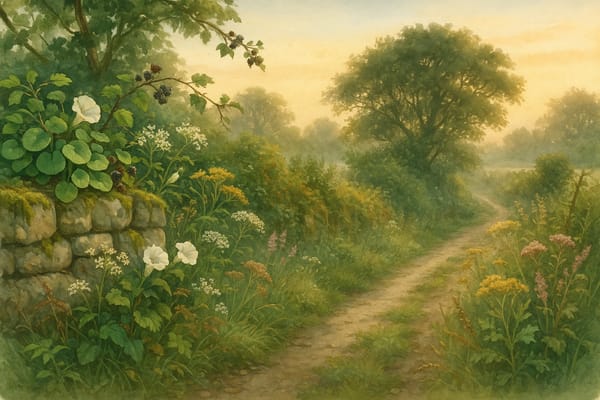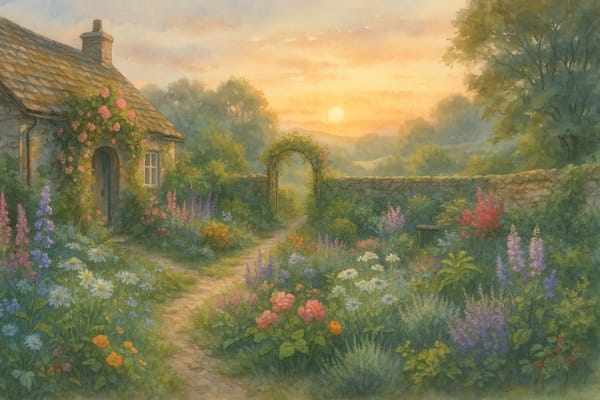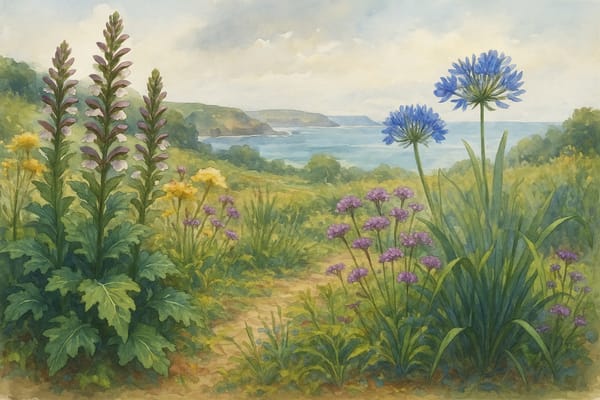In the soft morning light, a Cornish hedgerow glistens with dew. Navelwort cups hold the last of the night’s rainfall, bramble shoots wind through hawthorn, and somewhere in the damp undergrowth, the scent of chamomile stirs with the memory of grandmothers and green cures. This is no ordinary landscape—it’s a living archive.
Across Cornwall, wildflowers, cultivated heritage varieties, and native shrubs hold stories. Not just the tales whispered through folklore, but knowledge—medicinal, culinary, spiritual—carried in the hands of foragers, herbalists, gardeners, and farmers for generations. Today, this entwined relationship between people and plants is being revalued as part of Cornwall’s biocultural and ethnobotanical heritage—a movement that treats cultural knowledge and biodiversity as one, inseparable whole.
What Is Biocultural Heritage?
At its heart, biocultural heritage is the recognition that biological diversity and cultural traditions are interwoven—not parallel strands but a braid. This idea stretches far beyond botany. It includes language, seasonal rituals, farming techniques, land rights, spiritual practice, and local governance. Crucially, it acknowledges that protecting plants cannot be divorced from protecting the human cultures that have shaped—and been shaped by—them.
In Cornwall, this framework provides a powerful lens for conservation and renewal. The plants of the peninsula are not just species; they are cultural signposts. To lose them, or the wisdom behind their use, is to lose a piece of Cornwall’s identity.
Folk Remedies, Foraged Feasts, and Garden Rituals
Long before “wild food” and “plant-based healing” became modern trends, Cornish households looked to the hedgerow and garden for sustenance and medicine. This knowledge wasn’t learned from books. It was passed from palm to palm, often by women—herbalists, healers, mothers—who knew exactly when to gather plantain for wounds, or how to blend elderflower with chamomile for fever.
Some practices remain vivid. Navelwort (Umbilicus rupestris), with its succulent leaves, still peeks from Cornish stone walls and is enjoyed as a crunchy salad green. The three-cornered leek (Allium triquetrum), abundant in spring, serves as a regional wild garlic. Heather and elderflower, once dried for tea, are seeing a revival in home herbalism.
Even more obscure knowledge is being uncovered. The pillas oat—a “naked” oat grown in ancient fields—is making a quiet comeback, studied by heritage seed initiatives aiming to reintroduce it as part of Cornwall’s food future.
And then there are the healing charms: bramble rubbed thrice against skin to banish warts, ivy leaves steeped in milk for coughs, rowan twigs hung in doorways to ward off bad spirits. In such stories, medicine and myth blend—a reminder that health was once understood as a balance between body, land, and spirit.
Emblems of Place: The Power of Native Plants
Among Cornwall’s plant treasures is Cornish heath (Erica vagans), found mainly on the Lizard Peninsula. More than a botanical rarity, it’s a symbol—a floral emblem that represents regional pride and ecological uniqueness. Like the Cornish Aromatic apple or the Kea plum, it speaks of soil, slope, climate, and history, and is rooted in both biology and belonging.
This sense of plant-as-place is echoed in other species: betony, once a cure-all said to be good for “forty ailments,” now a gardener’s delight in heritage plantings; plantain, praised in medieval texts and still used today for bites and stings; cleavers, once used to strain milk, revealing old foodways hidden in weeds.
These aren’t just curiosities—they are cultural markers, still growing underfoot, still blooming in hedgebanks and meadows, quietly defying the erasure of knowledge.
Gardens as Living Archives
One of the most powerful responses to this vanishing knowledge is the rise of ethnobotanical gardens. These aren’t ornamental displays. They’re curated ecosystems, blending native plants, folk crops, and community stewardship. They are living archives—educational, edible, and sacred.
In Cornwall, places like The Lost Gardens of Heligan, Trebah, and Caerhays act as conservatories of both horticulture and memory. Rare subtropical species rub shoulders with medicinal herbs once grown in cottage gardens. Families who’ve cared for these estates over generations carry not just land rights but cultural responsibilities.
Community projects also play a vital role. Inventories of local plant knowledge—compiled from oral histories, elder interviews, and foraging walks—are forming the basis for grassroots ethnobotanical initiatives. These may lead to new gardens, school programs, or seed-saving schemes rooted in local resilience.
Landscapes of Memory: Where Nature and Culture Converge
Cornish landscapes are etched with biocultural signatures. The field patterns on Bodmin Moor, the “vertical meadows” of Cornish hedges, and the mining-scarred cliffs above Porthtowan all bear witness to the intersection of ecological and human history.
Protected areas such as Sites of Special Scientific Interest (SSSIs) now include criteria that blend ecology with historic land use—recognizing that wild thyme or rock samphire growing on a centuries-old wall may have as much cultural value as biological.
Elsewhere, projects are reviving traditional land-use practices: coppicing, grazing, and orchard restoration—always with the understanding that landscape health is entwined with cultural memory.
The Cornish revival of ethnobotanical heritage is not a nostalgic retreat. It is an act of cultural and ecological adaptation.
Workshops on wild food foraging are sold out. Herbal medicine circles are sprouting in coastal towns. Artists and educators are collaborating on plant lore zines, storytelling walks, and Cornish-language garden signage. There is talk of a regional Biocultural Heritage Atlas—part map, part archive, part rewilding manifesto.
In an age of ecological crisis, these efforts offer something radical: the belief that healing the land and healing the culture are one and the same.
The Way Forward: From Knowledge to Stewardship
Preserving Cornwall’s ethnobotanical heritage is not simply about nostalgia. It is about ensuring future relevance. It means seeing community herbalists as stewards of genetic diversity. It means funding seed banks not just as biological repositories, but as keepers of story. It means honoring the hands that knew when to harvest and how to heal.
Ethnobotany, at its best, teaches us to see the plant not just as species, but as relative—as kin. In doing so, it invites us to reimagine conservation not as extraction, but as relationship.
And that, perhaps, is the deepest wisdom Cornwall’s plant lore offers: a slow, reciprocal, rooted way of being with the earth.











